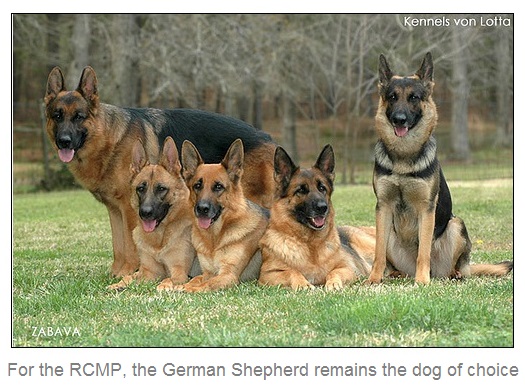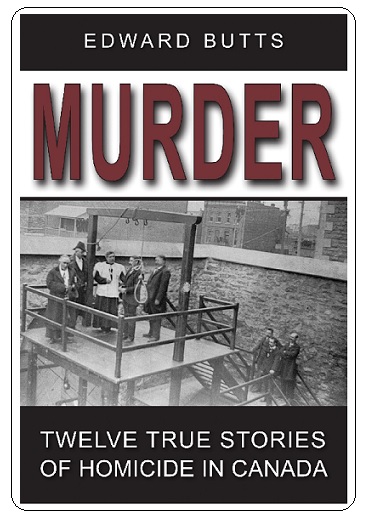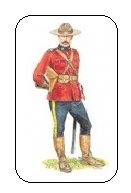True and Fascinating Canadian History

Vet of the Month: April 2009
RCMP Police Service Dog: Klia
RCMP Vets. Ottawa, ON
(Defence lawyer for the accused Haase)
Murder Case - 1964

I joined the Force forty-five years ago and I weighed about 140 lbs. In those days, since I had recently graduated from ‘Depot’, I could run on duty alongside most of the Dog Masters on the Lower Mainland of Vancouver, BC. Chasing the Police Service Dog (PSD) through the woods and along highways was an exciting venture and one’s adrenalin ran high most especially when the dog’s vice-grip clutched the ankle of a car theft runaway ‘client’.
Time and time again, I marvelled at the skills, ability and strengths of our Dog Masters and the proven obedience and talent of their partners. I wish to acknowledge the extraordinary contributions made to investigations by RCMP Dog Masters and Police Service Dogs. Many cases have depended upon the expertise of these teams to help bring about justice. In particular, I remember Police Dog Master Constable Laurie Marshall.
In late 1963, the Dog Master at Kamloops, British Columbia received a call for help from Enderby Detachment. It had been reported that two teenage daughters had disappeared after school.
An intense search, involving the Dog Master and an RCMP dog, began immediately in a wooded area near to the school. The tracking ability of the PSD led to material discoveries including school books and clothes. The all night search ended tragically when the PSD led his master through the woods to the sites of the bodies of the two girls.
Soon afterward, a suspect male identified as Lawrence Herman Haase walked out of the woods. Haase was arrested as a possible suspect for murder, however, there was no physical evidence connecting him directly to the ghastly crimes.
The Dog Master decided to back track from the point in the woods where Haase was first seen. Not far into the woods, the Dog Master retrieved a flashlight which was in working order. The Dog Master, following the lead of the PSD, continued to follow the track back and forth to the edge of a river and then back into the bush.

Eventually, the Dog Master’s attention was drawn by his canine partner to search more intensely between two rotting logs. There a man’s bloodstained shirt was discovered. In addition, the RCMP dog guided the Dog Master to a camp fire which was still burning deep in the woods.
In the meantime, the suspect Haase made several statements to the investigating members confessing to the murders. He provided information about the murder weapon, a rifle. In spite of a systematic search by civilian volunteers and RCMP members, the rifle barrel could not be found.
It was decided that all members of the search party would be withdrawn from the woods in order to leave the search alone to the Dog Master and his partner. After four days of intense searching, the RCMP dog focused on a hollow log and when the Dog Master tore the log apart, he found the .22 calibre rifle barrel which had been missing. The evidence allowed charges of murder to be laid against the suspect Haase.
The murder trial began and one of the chief witnesses was the Dog Master. The Dog Master testified to the marvels of his partner ‘Klia’. It was the dog’s extraordinary tracking ability that uncovered the needed evidence at the murder scene.
At the point in the trial when the judge, Judge A. H. McLean, instructed the jury he made a remarkable statement when he noted that, to his knowledge, this case marked the first time in a Canadian Court when the evidence provided through the efforts of a Dog Master and his Police Service Dog was totally accepted.
On March 6, 1964, Haase was convicted of Capital Murder. He was sentenced to hang.

At the time of the search for the young girls and the uncovering of the evidence that had led to their deaths, Police Service Dog ‘Klia’ was only 13 ½ months old. Klia was an extraordinary asset to this police investigation. The tireless, exact and concentrated efforts of not only Klia but all Police Service Dogs are worthy of our grateful acknowledgement.
We congratulate all our Dog Masters and our Police Service Dogs and we thank you.
‘Klia’ our friend and our Dog Master’s partner is our Special April, 2009 Vet of the Month.
Source:
Summarized from: Report of the Royal Canadian Mounted Police: Fiscal Year Ended March 31, 1964. p.50.
Reporting from Fort Healy,
J. J. Healy
June 23, 2013

A personal account from Mike Morris, MLA
Prince George-Mackenzie
The following story was sent to me on May 5, 2020 from retired RCMP Officer Mr. Mike Morris, Provincial MLA for the Riding of Prince George-Mackenzie.
My short story about Police Service Dog Klia struck a chord with Mike Morris because he was a small boy in 1963, and he was the last person to have seen the two girls before they were abducted and killed.
Good afternoon Joe,
I came across your story just this morning, interested because I myself had some involvement in that case. I retired from the Force in 2005 as the District Officer for northern BC. My Reg.# were #30651 and O.1689. I once had an Instructor in 'Depot' in 1973 by your name – perhaps it was you?
I entered politics in 2013 and I was the Solicitor General and Minister for Public Safety prior to the BC provincial election in 2017 when we lost government. I am currently the critic for Public Safety and the MLA for Prince George, BC.
I lived in the small community of Kingfisher near Mable Lake, BC at the time (October 10, 1964). I was the last one to see the two deceased young girls before they met their gruesome death. My father was the school bus driver and my job was to watch for his arrival and open the gate for him to back into the yard and fuel up the bus.
The Ring twins were a couple of years older than me and they lived a short distance down the road as their parents operated the Mable Lake resort. Once my father had backed the bus in, the girls disembarked and I chatted with them for several minutes before they commenced walking home. My father walked to our rental home about 100 feet away from where he parked the bus.
I went inside the house after the girls departed and I sat down with my parents, brothers and sisters to have dinner. It was approximately an hour after the girls left that their father came to our home and asked if the girls had come back on the bus. I had to explain that I had chatted with them and watched them walk towards their home until they disappeared behind some bush a hundred yards or so down the road. My father went with their dad and they found some schools books and scuff marks on the road in behind our house. Later, the two bodies were found not too far from there.
The community rallied and locals commenced a man hunt, most carrying either a rifle, shotgun or baseball bats for protection. It was a sleepless night for everyone in the community as the suspect was still at large. It was early in the morning that the suspect turned himself in to Mr. Flynn, our neighbor. I was subpoenaed as a witness at the subsequent trial held in Supreme Court in Kamloops the following spring (late February and into March). It was quite the experience for a young boy. Because of my father’s nefarious past, media outlets also pointed to him as a possible suspect prior to the trial.
The deaths were a devastating event for the entire community. The victim’s family soon moved out of the community to escape these tragic circumstances. The suspect Haase was found guilty on both counts and he received the death penalty for one twin and life in jail for the other. There was an unsuccessful appeal in 1965 and a subsequent Order in Council by the federal government to reduce the death sentence to life imprisonment. My oldest brother Dave Morris (Reg#22147) was in 'Depot' during these events.
I was researching the story about the two girls is in order to put the events together for my brothers and sisters who all well remember the crime. We often recall when we all get together.
Best regards
Mike Morris, MLA
Prince George-Mackenzie
Phone: (250) 612-4194
Fax: (250) 612-4191
E-Mail: mike.morris.mla@leg.bc.ca
Address: Unit 102 – 1023 Central Street West,
Prince George, BC V2M 3C9

The following notes were received from Mr. Doug Mullins on May 6, 2017. As it turned out, Mr. Mullin'sfather was the defence lawyer for the accused Haase in the murder case.
Dear Mr. Healy;
"I just read with much interest your RCMP Graves article covering "Vet of the Month: April 2009, Police Service Dog Klia”.
This case involved the investigation and murder trial of Lawrence Herman Haase. My father Norman D. Mullins, Q.C. acted as defence lawyer for Haase at his trial. My father passed away in January of this year but left, in his unpublished memoirs, the following perspective on his initial involvement in the Haase case. Unfortunately, it appears that he did not finish this particular memoir but he defended Haase until the conclusion of the case.
I was 11 years old at the time but I do remember my father’s discussions of the Haase case at home. Among other things, he mentioned the RCMP search dog and the role it’s work played in the trial. One thing that sticks in my memory is that one of the officers, possibly the dog master, had a plaster cast on his arm. At one point during the search, the dog started barking excitedly and the officer immediately tried to pull his is gun from its holster. Unfortunately the cast prevented him from doing this.
Not knowing whether the murderer or an accomplice might be the cause of his dog's barking, the officer broke the plaster cast on his arm in order to reach and remove his gun for protection. As I recall, the dog was barking after locating evidence important to the trial.
I should add that my father worked extensively with the RCMP in Kelowna (1958 to 1965) and later in Vancouver with the Department of Justice and he clearly enjoyed his association with the RCMP.
I am assembling my father’s memoirs and would like to know if you would have any objections to my incorporating the text of your April 2009 article, properly referenced to you and your web site.
I’m not sure where the final memoir will go but initially I plan to share it with family, friends and possibly legal colleagues of my father.""
Yours truly,
Doug Mullins
Memoirs by Norman D. Mullins, Q.C.
(Defence lawyer for the accused Haase)

"As a result of renovations in the office of our firm in Kelowna, we had a small roomadjacent to our law library ideal for quiet research and dictation. Exclusive use of the room wasassigned on a lawyer-day basis among the five members of the firm on the understanding thatnothing and no one was to disturb a lawyer on his blessed opportunity to try to catch up on his backlog of work.
Tuesday was my day in the isolation ward and one time, following a Remembrance Day holiday, I was revelling in the cleanup of a multitude of problems when a timid rap came on thedoor. Our receptionist said Peter Ratel, a local service station operator with whom I worked on
The Chamber of Commerce executive, had asked me to call him. I snappishly replied that it wasmy day in solitary and she should have asked him on to one of the other lawyers. She rep rethought jokingly, that it was about "the murder." With unwitting prescience, I told her that I didn't care if it was about a mass murder, I was not going to give up my precious free work time. She said, "Haven't you heard? His service station attendant, Larry Haase, has been charged with murdering twin sisters at Enderby."

Kelowna in those days was a pretty small town and relatively free from major crime but what made this report more startling was that I knew Haase and couldn't believe he could have done anything as terrible as this news suggested. He was a friend of the son of my next door neighbour with whom I had spent many hours discussing construction and operation of high-fi stereo equipment. On one occasion, my neighbour had taken me to Haase's suite to look at and listen to a magnificent combination of units Haase had put together and I was impressed with the courtesy and kindness of this seemingly happy newly-wed young man.
My "quiet day" was irretrievably ruined and so I called Pete Ratel who had little to add to the brief report I had already received. He was in total shock over the event because, like me, he couldn't believe Haase could possibly have committed the crimes charged against him. I agreed to go with him right away to see Haase and provide whatever legal help might be necessary.

The Royal Canadian Mounted Police office in Enderby at that time was a tiny former store cut up in a rudimentary way into a miniscule office for the Magistrate, a small outer office with a counter, and a back room with a barred wall marking off a holding cell big enough for only one or two people. There were no policemen in the office but a secretary told us that Haase had already been transported to the R.C.M.P. office at Salmon Arm. Before driving the twenty miles or so to that town, Pete and I decided to go to the scene of the crime about ten miles East of Enderby near Mable Lake.
I had heard and read a good deal about hillbilly country and followed the cartoon adventures of Li'l Abner for years but I had never seen anything like the conditions described in those sources until we made that trip into the backwoods of lower central B.C. The road was barely gravelled; it rose and fell and twisted this way and that. Alongside were miserable little farms with a couple of cows and some scruffy cross-bred chickens wandering about. Our passage was blocked for a time by a slow moving flock of mangy looking sheep. The occasional rusty sawmill’ overflowing with useless pine bark and dirty sawdust, lay rotting away amid 21 muddle of broken down trucks and tractors.

Haase and his wife had been celebrating their first wedding anniversary by spending the holiday week-end with her parents whose home was on this road. Pete and I thought we should speak to them while we were in the vicinity. I didn't really address my mind as to what their house would look like but I was appalled when I saw it. It was constructed of every piece of reject shiplap lumber that could be retrieved from the scrap heap of the nearest gippo sawmill and had not even been painted to cover up the great areas of dry rot and loose knots.
The roof had open gable ends so that you could see right through. Pete wryly pointed out to me the "insulation" which consisted of about a foot of raw sawdust poured over the ceiling to keep the bitter winter cold out of the rooms below. I never did see the inside since no one answered our knock on the slivered front door.
We continued along the road until we came to an intersection where we were waved down by a uniformed Mountie. Investigation work was still going on and we could proceed no farther. Fortunately, I noticed Corporal Jack Fehr, the "Ident man" of the Kelowna R.C.M.P. detachment. He told us he had completed his search for evidence and taking of photographs and offered to walk us over the relevant sites. There was little to be seen beyond a few specks of blood on leaves and some scuff marks in the dirt of the road.

Jack gave a quick summary of what he thought had happened. Fifteen year old twin sisters X and Y Ring had ridden the school bus as far as the residence of its driver just West of the junction we had passed. On foot they continued down the road towards their home at a fishing lodge on Mabel Lake. A short distance east of the junction they had been attacked and stabbed to death. The body of one girl was found in the bush in one location and that of her sister quite a distance away in the bush on the other side of the road. A suspect had been arrested within a mile of the scene. We left to go to Salmon Arm to see Haase.
At the considerably more commodious Court House and police station, I explained our purpose and was eventually turned over to a tired looking R.C.M.P. Staff Sergeant who reluctantly took me to the cell in which Haase was being held. The police had taken all Haase's clothing for examination and had provided him with rough coveralls and a pair of heavy boots. Considering the terrible accusations made against him, Haase appeared remarkably calm although he too looked weary.
I was so struck by the horror of the deaths of these innocent children that I was really in no mood to delve into the grim details of what had happened and I assumed Haase must have felt the same way. He had not seen a lawyer or thought about hiring one and was content to have me act for him at least at this time. I decided not to question him but said that I assumed he had made some statements to the police about which I could do nothing at that time and, as firmly as I could, I advised, urged, ordered that he say nothing else about the case to anyone other than me.

Considering the gross cruelty of the murders and the utter inconsistency between Haase's character, as I knew it, and these brutal acts, I gave him an additional warning: "At this moment, the only defence I can perceive is one based on some sort of insanity. In all murder cases, the province has its own psychiatrist, possibly Dr. Joe Thomas, speak to the accused.
The only reason for him doing so is to try to get evidence to rebut any defence of insanity. Therefore it is in your interest that you say nothing whatever to Dr. Thomas. I would prefer that you refuse to see him at all but if you cannot avoid doing so, SAY NOTHING. That is your right. It is a matter of your life or death. Do not talk to him!"
With that concluded, I returned to Kelowna with poor, downcast Peter. Over and over he repeated how difficult it was to believe that this loyal, hard working employee, loved by all who knew him for his gentleness and willingness to help with chores large and small, could have done such awful things. I was left to ponder the unlimited vagaries of the human mind and to plan where next I would go in this horrible case."
Unfinished Memoir by Norman D. Mullins, Q.C.
Dear Mr. Mullins,
Thank you so much for your note. It has brought back some wonderful memories…about living on the west coast, Police Dogs and their handlers.
But, I am also sad to hear that your father Mr. Mullen Sr. has passed away. I would loved to have met him, and to talk about this particular case. I began my career in Burnaby in 1965, and I spent five years between Burnaby, Surrey and Ridge Meadows then to the east coast and closer to my family. I wish that we had crossed paths while I was in the west.
You have my full permission to use or reprint the Vet of the Month story…I am so glad that you found it, and that you can add it to your father’s notes.
The Identification RCMP was Regimental #17823, Corporal Jacob Fehr — over his long career, he served all across Canada. I checked his name in my database, and discovered that he served from 1952 to 1985. He died in 1991, and he was buried in Bedford, NS. If you do a search of his name or his Regimental # in my database, you will also see a photo of his grave marker.
If you happen to find more references to this case in your father’s files, please let me know.
Once again, thanks for your note. I send you all my best.
Yours truly,
Joe
Ottawa
May 7, 2017





